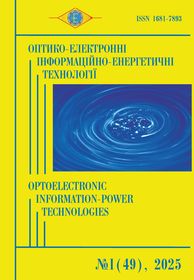Analysis of decision support methods in polarization introscopy systems of biological tissues and fluids
DOI:
https://doi.org/10.31649/1681-7893-2025-49-1-185-192Keywords:
decision support method, machine learning, neural networks, fuzzy logic, biological layer, system, polarization introscopyAbstract
The article discusses the features of the application of decision support methods based on machine learning, fuzzy logic and neural networks in polarization introscopy systems of biological objects. It was determined that methods such as fuzzy logic, some machine learning methods (decision trees, XGBoost) and neural networks (multilayer perceptron) allow to achieve an increase in the accuracy of polarization diagnostics of BS to the level of 81-98%. However, the obtained accuracy results may be overestimated due to the imperfection of the evaluation models and methods of sample formation, which requires further research. A comparative analysis of their accuracy characteristics is presented, taking into account the input data, software implementation and the type of pathologies diagnosed in the introscopy system.
References
Alalia, S., Vitkin, A., “Polarized light imaging in biomedicine: emerging Mueller matrix methodologies for bulk tissue assessment,” J. Biomed. Opt. 20(6), 061104 (2015).
Znan, H., Voelz, G., and M. Kupinski, “Parametr-based imaging from passive multispectral polarimetric measurements,” Opt. Express 27, 28832 (2019).
Lee, H. R., Li, P., Yoo, T.S. et al., “Digital histology with Mueller microscopy: how to mitigate an impact of tissue cut thickness fluctuations,” J. Biomed. Opt. 27 (7), 076004 (2019).
Vasyuk, V.L., Kalashnikov, A.V., Ushenko, A.G. et al., “Digital Information Methods of Polarization, Mueller-Matrix and Fluorescent Microscopy,” Springer Nature Singapore, 2023. 102 p.
Zabolotna, N.I., Sholota, V.V., Okarskyi H.H., “Methods and systems of polarization reproduction and analysis of the biological layers structure in the diagnosis of pathologies,” Proceedings of SPIE. 11369, 113691S, P. 501-513 (2020).
Khan, S., Qadir, M., Khalid, A. et al., “Characterization of cervical tissue using Mueller matrix polarimetry,” Lasers in Med Scienc. 38 (1) (2023)
Jiao, S., Wang, L. V. “Jones-matrix imaging of biological tissues with quadruple-channel optical coherenct tomography,” J. Biomed. Opt. 7(3), 350–358 (2002) doi: 10.1117/1.1483878.
Zabolotna, N. I., Radchenko, K. O. and Karas, O.V., “Method and system of Jones-matrix mapping of blood plasma films with “fuzzy” analysis in differentiation of breast pathology changes,” Proc. SPIE 10612, 106121P (2018).
Ushenko, A.G., Zhytaryuk V.G., Vanchulyak, Ya. O. et al., "Statistical and cross-correlation structure of Jones-matrix images of polycrystalline films of biological fluids," Proc. SPIE 10977, Advanced Topics in Optoelectronics, Microelectronics, and Nanotechnologies IX, 109773T, December 2018. https://doi.org/10.1117/12.2323586.
Zabolotna, N.I., Dovhaliuk, R.Y., “Orientational tomography of optical axes directions distributions of multilayer biological tissues birefringent polycrystalline networks,” Proc. SPIE 8873, 887313 (2013).
Zabolotna, N.I., Oliinychenko, B.P., Radchenko, K.O. et al., “System of polarization phasometry of polycrystalline blood plasma networks in mammary gland pathology diagnostics,” Proc. of SPIE 9613, 961311; (2015).
Ushenko, Y. A. et al., “Diagnostics of Structure and Physiological State of Birefringent Biological Tissues: Statistical, Correlation and Topological Approaches,” Handbook of Coherent_Domain Optical Methods, New York: Springer Science+Business Media, 107–148 (2013).
Qin, Z. et. al., “How convolutional neural network see the world: a survey of convolutional neural network visualization methods,” CoRR abs/1804.11191 (2018).
Zadeh, Lotfi A., “Fuzzy logic: principles, applications, and perspectives,”. Proc. SPIE. Vol.1468. (1991).
Osisanwo, F. et al., “Supervised machine learning algorithms: classification and comparison”, Int. J. Comput. Trends Technol. 48 (3), 128-138 (2017).
Majumdar, A., Lad, J., Tumanova, K. et al., “Machine learning based local recurrence prediction in colorectal cancer using polarized light imaging,” J. Biomed. Opt. 29(15), 052915 (2024).
Robinson, D., Hoong, K., Kleijn, W. B. et al., “Polarimetric imaging for cervical pre-cancer screening aided by machine learning: ex vivo studies,” J. Biomed. Opt. 28(10), 102904 (2023).
Radchenko, O.K., “Intellectualized Mueller-Jones matrix system of laser polarimetry for breast fibroadenoma diagnosis,” Proc. SPIE 10750, 107500M (2018); doi: 10.1117/12.2320130.
Zabolotna, N.I., Sholota, V.V. “Metod ta pidsystema pidtrymky pryiniattia rishennia dlia miuller-matrychnoi lazernoi poliaryzatsiinoi diahnostyky biolohichnykh tkanyn”, Optyko-elektronni informatsiino-enerhetychni tekhnolohii 1, 43-52 (2022).
Zabolotna, N. I., Sholota, V. V., Satymbekov, M., Komada, P., “Azimuthally invariant system of Mueller-matrix polarization diagnosis of biological layers with fuzzy logical methods of decision-making,” Proc.of SPIE, 12476, 1247608 (2022) doi: 10.1117/12.2659208.
Zabolotna, N., Sholota, V., Zhumagulova, S. et. al., “System of polarization mapping and intellectual analysis of Mueller matrix invariants of biological layers in the assessment of pathologies,” Proc. SPIE 12985, 129850Q. (2023) doi.org/10.1117/12.3023049.
Downloads
-
pdf (Українська)
Downloads: 37
Published
How to Cite
Issue
Section
License
Автори, які публікуються у цьому журналі, погоджуються з наступними умовами:- Автори залишають за собою право на авторство своєї роботи та передають журналу право першої публікації цієї роботи на умовах ліцензії Creative Commons Attribution License, котра дозволяє іншим особам вільно розповсюджувати опубліковану роботу з обов'язковим посиланням на авторів оригінальної роботи та першу публікацію роботи у цьому журналі.
- Автори мають право укладати самостійні додаткові угоди щодо неексклюзивного розповсюдження роботи у тому вигляді, в якому вона була опублікована цим журналом (наприклад, розміщувати роботу в електронному сховищі установи або публікувати у складі монографії), за умови збереження посилання на першу публікацію роботи у цьому журналі.
- Політика журналу дозволяє і заохочує розміщення авторами в мережі Інтернет (наприклад, у сховищах установ або на особистих веб-сайтах) рукопису роботи, як до подання цього рукопису до редакції, так і під час його редакційного опрацювання, оскільки це сприяє виникненню продуктивної наукової дискусії та позитивно позначається на оперативності та динаміці цитування опублікованої роботи (див. The Effect of Open Access).


